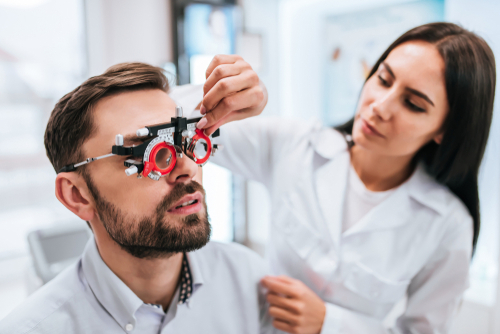What Exactly Is A Routine Eye Examination?

A routine eye examination should be part of everyone’s year. Scheduling a visit with your eye doctor is vital when it comes to preventing eye problems.
If you have any eye conditions, routine eye exams help treat current issues with your vision before they become more destructive. A routine eye exam is different than a medical eye exam.
A medical eye exam produces an official diagnosis, whereas routine eye exams simply screen for diseases and problems. Keep reading for more information about routine eye exams!
Comprehensive Exams
A comprehensive eye examination is designed to give your eye doctor a good understanding of the current state of your vision. To do so, it is important for your doctor to test many different aspects of your vision. Here are a few examples.
Alignment Tests
Testing the alignment of your eyes means that the doctor is ensuring that your eyes’ muscles are working in tandem. During this test, the doctor will observe your eyes as they track a moving object.
Visual Acuity
This is one of the most common tests. During a visual acuity test, your vision at a distance will be evaluated. You will sit precisely 20 feet away from a poster that has rows of letters on it.
The rows of letters grow smaller and smaller from top to bottom and are labeled with a number relating to the size of the letter. If from 20 feet away you are able to correctly identify the letters on the line labeled “20”, you have 20/20 vision.
Ophthalmoscopy
If your doctor feels the need to look at your retina, you may undergo an ophthalmoscopy test. During this test, your eyes will be dilated. Your eye doctor will use a device called an ophthalmoscope to look at them.
This will give the doctor insights on many potential and serious problems such as retinal detachment, diabetic retinopathy, and macular edema. all of these can cause serious damage to your vision and even blindness.
Glaucoma Test
One of the most important things to test for is glaucoma. This is because it is not identifiable without an eye care professional. In almost all situations, glaucoma is a symptomless condition.
Diagnosing glaucoma early on is the only way to avoid vision loss. Any vision loss because of glaucoma is irreversible. The progress of the disease can only be stopped with immediate medication intervention.
To test for glaucoma, your eye doctor will determine how high your eye pressure is. High internal eye pressure is a clear sign of potential glaucoma.
To do this, the doctor uses a tonometer, which puffs air out into your eyes. The machine measures how well your eyes resist the puff of air. It then interprets that reading into eye pressure levels.
Slit Lamp Exam
The doctor may use a machine called a biomicroscope to examine certain parts of your eyes for problems. This includes the cornea, the iris, the lens, and the retina.
There are many other tests that may be useful in your case and which ones are necessary is determined by your eye doctor.
Looking to schedule an eye exam? Contact the experts at Vermont Eye Laser in Burlington, VT!



